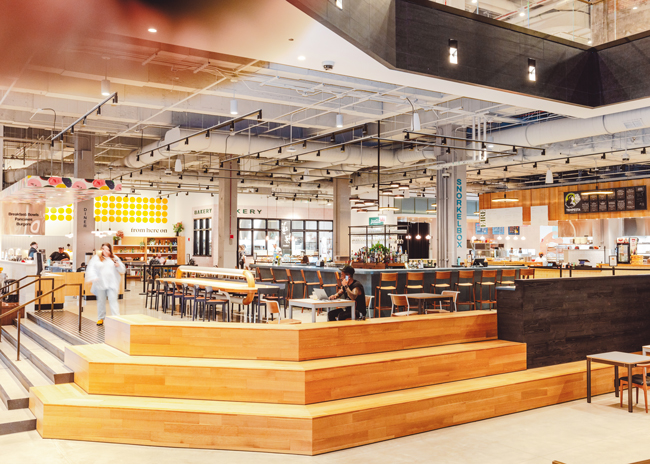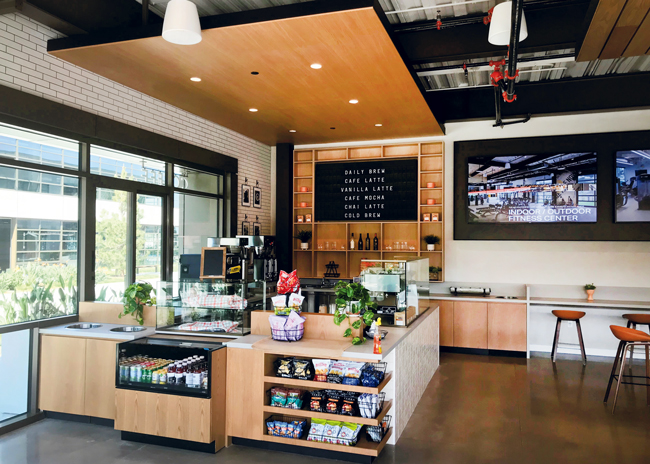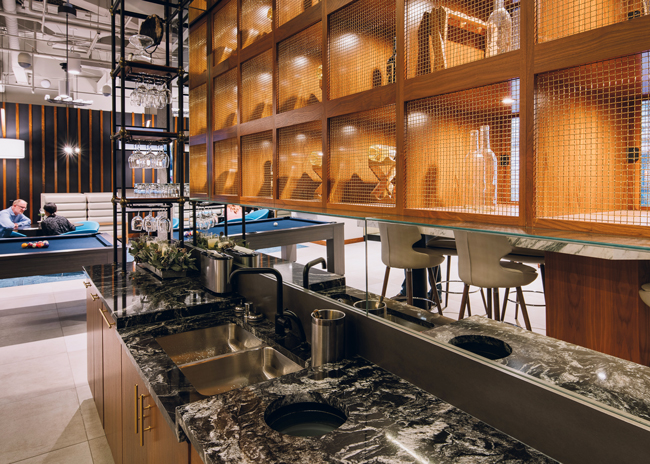White-collar workers are somewhat returning to urban office buildings and suburban corporate campuses, but no big shifts have occurred, which leaves those running foodservice offerings still figuring it all out.
Business and industry (B&I) foodservice purveyors have adjusted faster to greater change in the last three years than perhaps in the half century prior to 2020. Their nimbleness — in both the pandemic period and post-pandemic recovery — is a good sign that they’ll be able to adjust to any trends in the nation’s workplaces for years to come.
 Four out of five diners at Chicago’s From Here On work in the building that houses the food hall. Photo courtesy of 16OC“Corporate dining has really been a challenge, especially for management companies that signed an agreement prior to COVID,” says foodservice design consultant Arlene Spiegel of New York City-based Arlene Spiegel & Associates. “And now, they’re struggling to reimagine their contracts with clients,” she says. Employers increasingly view foodservice as an “incentive, reward and enticement” for returning and new staffers.
Four out of five diners at Chicago’s From Here On work in the building that houses the food hall. Photo courtesy of 16OC“Corporate dining has really been a challenge, especially for management companies that signed an agreement prior to COVID,” says foodservice design consultant Arlene Spiegel of New York City-based Arlene Spiegel & Associates. “And now, they’re struggling to reimagine their contracts with clients,” she says. Employers increasingly view foodservice as an “incentive, reward and enticement” for returning and new staffers.
There’s hard evidence that office employees respond to foodservice incentives. A 2022 study of 2,000 workers who had returned to the office at least part-time, conducted by the architecture and design firm Gensler, concluded that “workplaces that are both effective and offer great experiences provide access to a range of spaces.” When respondents were asked to list the ideal mix of office amenities they’d like to see, the presence of a coffee shop came in first for all generations but Baby Boomers, who rated it second. About eight in 10 employees whose offices have a cafe or cafeteria on-site called it a “great experience” in their workday.
As employers focus on foodservice to please their workers, companies that own office buildings are under the same pressure to offer higher-end food services as an amenity. Employers shopping for office space can afford to be choosy since there’s a lot of square footage standing empty.
“The U.S. office sector is facing an unprecedented imbalance in supply and demand — one that will result in an excess of 330 million square feet of vacant space by the end of the decade,” Cushman & Wakefield, a commercial real estate services firm, declared in its recently released research report optimistically titled “Obsolescence Equals Opportunity.” The report identifies a number of opportunities to make office buildings stand out, including community-building hospitality services, access to outdoor spaces, and a variety of food options.
Doing More for Fewer
In many if not most cases, pre-pandemic foodservice operations won’t work in today’s offices, Spiegel says, if only because these facilities feed fewer people each weekday compared to 2019. “Building ownership may have invested tons of money on cafes that are never coming back,” she says. “A facility that has been designed for 1,000 customers, and now serves only 400, creates so many inefficiencies. We’re still trying to figure things out.”
“There’s no one-size-fits-all solution to workplace design,” says Cori Kuechenmeister, director of design at Shea Inc., a design and marketing firm. “Hybrid spaces are popular because building owners and managers like to have flexibility as consumers and the workforce evolve. Common areas — lobbies, food and beverage areas, tenant lounges and outdoor spaces — have to serve all purposes, from working alone or with others to socializing and hosting events. The key is to create a space that doesn’t feel temporary but can be flexible for different times of day and different needs.”
Shea is working with several clients to replace traditional corporate cafeterias with market-style cafes or setups that offer multiple food stations and incorporate “space for socializing, or a third place outside of the home or office for working.” Another trend Kuechenmeister sees: central bars used for multiple purposes throughout the day, from coffee amenities in the morning to after-work, happy-hour food and drinks.
 Centrally located lobby bars that serve everything from coffee and pastries in the morning to happy-hour food and drinks after working hours are a trend in office dining projects, such as the Socca Café, shown here at the RBC Gateway Center in Minneapolis. A recent design project of Shea Inc., the ground-floor cafe is operated by the Four Seasons hotel also located in the building but serves primarily office workers in the tower and from other nearby buildings. Photo courtesy of Shea Inc.
Centrally located lobby bars that serve everything from coffee and pastries in the morning to happy-hour food and drinks after working hours are a trend in office dining projects, such as the Socca Café, shown here at the RBC Gateway Center in Minneapolis. A recent design project of Shea Inc., the ground-floor cafe is operated by the Four Seasons hotel also located in the building but serves primarily office workers in the tower and from other nearby buildings. Photo courtesy of Shea Inc.
You’d Better Have Something Interesting
In California, office building owners have upped their game to draw attention with foodservice and other amenities. “There are landlords building out incredible amenities when they don’t even have tenants yet; they’re using them to attract tenants,” says Mark Rossi, CEO and founder of California-based equipment dealer Avanti Restaurant Solutions. “As opposed to having rows of tables in a cafeteria, they’re using different types of spaces and cool hangouts to create experiences around foodservice. A little bistro coffee bar with murals on the wall, community collaboration areas and quiet rooms, an indoor-outdoor space with airplane hangar-style garage doors that can be opened, a gazebo outside with couches where you can offer entertainment. … You’d better have something interesting going on to draw people in.”
Avanti continues to work on office retrofits where landlords are “tearing out all the foodservice spaces, rebranding with their own cafe and bringing in an operator to run it,” Rossi says, as well as new builds with open-to-the-public food halls where operators “can come in, rent spaces for three to six months, and offer delivery for online orders. And they’re very item-specific — the doughnut concept, the fried chicken concept, the Korean barbecue concept.”
Food halls within a B&I space can operate in several ways. “Separate stations that could be branded concepts, with seating intermixed among them, are seen a lot,” says Ashley Pratt, a project manager at Webb Foodservice Design. “But some food halls in B&I are more flexible, with screens between the areas. You can bring in local restaurants for pop-up concepts, maybe feature something on a specific day or twice a week or once a month. Or the building’s foodservice staff can do pop-ups, like sushi every Wednesday.” Some concepts in food halls also offer frozen or ready-to-eat dishes for workers to take home for dinner.
Food halls — popular in office buildings, although less so as a specific corporate feeding solution — also offer a lot of bang for the buck because they can purvey a variety of food options from separate eateries up front but optimize efficiency with shared equipment in the back of the house, notes Marcin Zmiejko, associate principal at foodservice design and consulting company YoungCaruso.
 Foodservice in business and industry settings is heavily dominated by contract management companies such as Sodexo, which can often adapt ideas and recipes from one account to another. Sodexo’s research and conversations with clients led to the development of its Modern Recipe Café format, which emphasizes fresh, made-in-house, plant-based dishes like the Vegetarian Farro Bowl shown here. Photo courtesy of Sodexo
Foodservice in business and industry settings is heavily dominated by contract management companies such as Sodexo, which can often adapt ideas and recipes from one account to another. Sodexo’s research and conversations with clients led to the development of its Modern Recipe Café format, which emphasizes fresh, made-in-house, plant-based dishes like the Vegetarian Farro Bowl shown here. Photo courtesy of Sodexo
The Essential Role of Technology
What do employees most want in on-site foodservice today? “Speed and quality,” Rossi proclaims. “But speed trumps everything else. Nobody wants theater, open-flame cooking or front-of-house prep; they want their food in 4 minutes, not 8.”
The speed that office workers demand wouldn’t be possible without tech like online and app-based preordering, kiosks for ordering and checkout, touchless food pickup, cashless pay systems, and cubbyholes or lockers for those who prefer to pick up their lunch to eat elsewhere.
“The young workforce in particular is very comfortable with technology,” Spiegel says. “In truth, twentysomethings prefer not to talk to anyone; they’re very happy just to order for carryout. Workers can be on the phone or computer and can order lunch by mobile app for pickup or delivery at a certain time. Employees get tremendous convenience, and employers get much more productive time from their workforce.” In some buildings, ordering kiosks, not only in the dining room but near every elevator bank on every floor, provide an alternative preorder method, Spiegel reports.
Workers can also avoid human interaction when they pay for meals. “The self-service payment component exploded after COVID,” says Zmiejko of YoungCaruso. Some office dining facilities no longer accept cash at all, he says, and some operate on a prepaid, corporate-pass system.
And automation is being taken to the next level with “markets that are set up with the Amazon Fresh store model — you get an app, it tracks you within the servery spaces, notes what you pick up and automatically charges you,” Pratt reports.
 Food halls with a mix of dine-in and takeout restaurants, bars and retail offerings are a hot trend in office-building amenities. Olly Olly Market, which opened in the fall of 2022 on the ground floor of the Starrett-Lehigh Building in the Hudson Yards development in Manhattan, was developed by and is now managed by 16″ on Center, a company that has also created two ground-level food halls in downtown Chicago office buildings. In all three halls, tenants are limited to local operators. Photos courtesy of 16OCThe final component of this convenience model is the pickup area for carryout orders. While some operations use shelves or open cubbyholes, others have invested in lockers that can be opened with a QR code or punch code. Pratt says ambient-temperature lockers work fine, since most orders include both hot and cold items and employees tend to wait only a few minutes before retrieving their meals.
Food halls with a mix of dine-in and takeout restaurants, bars and retail offerings are a hot trend in office-building amenities. Olly Olly Market, which opened in the fall of 2022 on the ground floor of the Starrett-Lehigh Building in the Hudson Yards development in Manhattan, was developed by and is now managed by 16″ on Center, a company that has also created two ground-level food halls in downtown Chicago office buildings. In all three halls, tenants are limited to local operators. Photos courtesy of 16OCThe final component of this convenience model is the pickup area for carryout orders. While some operations use shelves or open cubbyholes, others have invested in lockers that can be opened with a QR code or punch code. Pratt says ambient-temperature lockers work fine, since most orders include both hot and cold items and employees tend to wait only a few minutes before retrieving their meals.
But Zmiejko sees a place for temperature-controlled lockers. “It depends on how the operation is functioning,” he says; for instance, a hot locker would be the best solution for pizza, either made to order in a deck oven or reheated from a frozen state in a speed oven.
Pratt notes another selling point for pickup lockers: Meals can be delivered to tenant spaces on upper floors and left in lockers in a workplace pantry. This convenience is especially important for workers who have only half-hour lunch breaks. And pantries with seating are an increasingly important office amenity, particularly since they can double as a company meeting or celebration space.
Vending is the ultimate in convenient foodservice that’s easy to install in either tenant spaces or a central location and can extend foodservice availability to 24 hours a day. “I see way more options for vending,” Pratt says.
“Pho bowls, smoothies, fresh salads, hot baked goods, coffee kiosks with automated robot arms.” Zmiejko notes “a machine that makes salads in front of you, a machine that makes pizza.” But, he points out, even these highly automated options don’t completely eliminate labor costs, since humans are required to restock and maintain the machines.
 A mix of indoor and outdoor seating is increasingly demanded by owners, managers and tenants of office buildings. Shown here is the Olive Grove Cafe at Innovation Office Park in Irvine, Calif., designed by Avanti Restaurant Solutions to replace an earlier bakery cafe that was torn out in a recent renovation. Photo courtesy of Avanti Restaurant Solutions
A mix of indoor and outdoor seating is increasingly demanded by owners, managers and tenants of office buildings. Shown here is the Olive Grove Cafe at Innovation Office Park in Irvine, Calif., designed by Avanti Restaurant Solutions to replace an earlier bakery cafe that was torn out in a recent renovation. Photo courtesy of Avanti Restaurant Solutions
Rethinking FOH & BOH
For both the servery and back-of-the-house equipment in B&I settings, flexibility is the keyword. “Not just the service point, but the whole serving station needs to be flexible so operators can rotate stations and menu items and shut down stations, but still be able to serve different menu items and styles of foodservice,” Pratt says. “That also helps when you have a hybrid-schedule office and don’t have as many people in the office on Friday as on other days.” One tool for flexibility she cites is an adjustable sneeze guard that can flip a salad bar from a staffed station to self-service and back. Countertop cooking equipment that can be moved around as needed is another way of providing flexibility.
Spiegel also mentions conversions of salad and soup bar stations from served to self-serve mode and calls out the usefulness of manufacturers’ servery modules with food wells that can be switched from refrigerated to ambient temperature to heated. “That allows for the same footprint to be used for specials and for different seasons,” she says. “Operators are also using chafing dishes and mix-and-match merchandisers to accommodate a variety of self-service food items. All that allows them to reduce labor without reducing the menu too much.”
Rossi notes the important role played by the latest generation of programmable combi ovens, often electric and ventless. “These have a bazillion ways to cook anything, and they really have artificial intelligence — they adjust the oven temperature and humidity as needed,” he says. “Pressure kettles are a big deal, too, because they can also cook larger amounts of food faster. After cooking, you can take the food from the kettle or combi to a blast chiller to extend its life. And vacuum sealing systems mean you can reheat foods to order as needed.”
Corporate dining will always be challenging, Zmiejko says. Within price, labor, equipment and facility constraints, “we need to offer good quality, fresh, healthy food,” he says. “At the same time, we always need to make sure we’re in agreement with what the office culture is moving toward.”
 Lounges shared by all building tenants and that feature spaces for working, socializing and preparing food are one amenity that enables a facility to stand out from other buildings competing for the same tenants. This one is at 60 South Sixth, a recently refurbished 40-story office tower in Minneapolis. Photo courtesy of Shea Inc.
Lounges shared by all building tenants and that feature spaces for working, socializing and preparing food are one amenity that enables a facility to stand out from other buildings competing for the same tenants. This one is at 60 South Sixth, a recently refurbished 40-story office tower in Minneapolis. Photo courtesy of Shea Inc.
From Here On: Passage to the Future of Employee Dining
After decades of vacancy and a $670 million renovation by Gensler, the Chicago building known as the Old Post Office was reborn as a multitenant office facility with class A amenities including a gym and a rooftop terrace. In August 2022, 16″ on Center (16OC), a firm specializing in restaurant, bar, food hall and music venue management, debuted the building’s new ground-level food hall, From Here On [FE&S September 2022, page 66].
From Here On currently hosts 10 concepts, including one it manages directly. In addition to the permanent tenants, there’s room for pop-up stall rentals of two weeks to three months. Tim Wickes, 16OC’s director of food hall operations, says the secret to success in food halls is “skin in the game” from tenants, who design their stalls, may set up no-contact ordering kiosks, and bring in their own cooking and refrigeration equipment, but share a back kitchen and two large warewashing stations.
Preorders, which account for 40% of business, include group and individual food deliveries to offices within the building, some of them paid for with stipend programs set up by office tenants. Customers order through centralized mobile ordering via a website. The management company also partners with Grubhub, DoorDash and UberEats for deliveries within and beyond the building. Prepared meals to take home for dinner are an important part of mobile preorders, Wickes says, especially for workers who commute by train.
Wickes believes the food-hall environment matches the priorities of companies that are bringing their employees back to the office — “less cubicle time, more open spaces, more employee-to-employee interactions” — as well as the desires of the companies that manage office facilities, particularly those that are old and unique. “There’s been so much office real estate left behind,” he says. “Now, you’re seeing landlords being much more creative in how they activate these buildings. Essentially, the resurgence of the office must come in the form of hospitality. It’s not only important, but necessary, to help employees shape their day around coming to work in the building.”
After work hours, Wickes believes 16OC’s oversight of music venues gives it a leg up on the all-important entertainment aspect of food hall management. He envisions art installations, cocktail competitions, live music and stand-up comedy nights in the future.
 A mix of seating types for individuals and groups, including lounge seating, increases the appeal of corporate dining areas for working, socializing and conducting meetings. Shown is the new 677 Washington Café in the 677 Washington building in Stamford, Conn., redeveloped from the former USB Financial Services headquarters. Photo courtesy of George Comfort and Sons/Arlene Spiegel & Associates
A mix of seating types for individuals and groups, including lounge seating, increases the appeal of corporate dining areas for working, socializing and conducting meetings. Shown is the new 677 Washington Café in the 677 Washington building in Stamford, Conn., redeveloped from the former USB Financial Services headquarters. Photo courtesy of George Comfort and Sons/Arlene Spiegel & Associates
Tricks of the Trade
Foodservice design consultant Arlene Spiegel of New York City-based Arlene Spiegel & Associates has seen and used a number of techniques:
- Rearranging furniture: “Cafes have taken out seats, added planters, created intimate seating areas that can be used for meetings and collaboration.”
- Rethinking servery stations: Some operators are “converting salad, soup and coffee bars that previously required an attendant to self-service.”
- More grab-and-go: “Not just snacks and pastries, but sandwiches and salads.”
- Hybrid marketplaces/convenience stores: “You can grab a croissant in the morning, pick up a deli sandwich or a salad for lunch, and also buy c-store staple items.”
- Outdoor spaces: “Tenants are using outdoor areas for team-building by offering things like barbecues.” One of Spiegel’s clients even parked an Airstream trailer outside the office building for after-work cocktail service.
- Lobby bars: This is “something you see often now in both newer and renovated buildings.”
- Catering: “Workplace and special-events catering provide a higher price point and better margins, helping foodservice contractors make up shortfalls from reduced employer subsidies.”
- Shared foodservice: “Some buildings are allowing — with security measures — partnerships with nearby buildings so those who work there can access their marketplace or cafeteria, increasing the worker population using the facility.”
- Ghost-kitchen aggregators: “These companies take five or six restaurants that they represent — Mexican here, Chinese there — and deliver everything to a
central spot in the lobby.” Some aggregators also operate food trucks.



